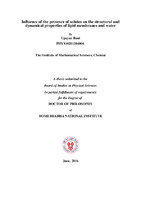Abstract:
In this thesis, titled Influence of the presence of solutes on the structural and dynamical
properties of lipid membranes and water, we report classical all-atom molecular dynamics (MD) simulation studies of two biological solvents, namely- phospholipid bilayers
and water, and their interactions with flexible, amphiphilic, polycationic antimicrobial
polymers and dissolved salts (ions) respectively.
For methacrylate polymers characterized by backbone amphiphilicity, we study the interactions of polymer aggregates with multiple model lipid membranes which include
models for both mammalian and microbial membranes. We conclusively show that the
polymers impact the structural properties of the microbial membrane models, with minimal effect on a mammalian one. For a model of E. Coli membrane, we suggest a mode
of antimicrobial activity through polymer induced demixing of lipid species, and associated phase boundary defects. We also report that the flexible methacrylate polymers with
no built-in facial amphiphilicity are capable of acquiring facial amphiphilicity in their
membrane partitioned phase. For side-chain amphiphilic polymers, in collaboration with
experiments, we show that the hydrogen bonding ability of polymers can impact their
antimicrobial activity.
Our studies reveal the effect of both monovalent and divalent cations on the long-range
dipolar orientational correlations in liquid water. Based on the observations, the ambiguous classification of ions as structure makers and breakers is challenged. The importance
of the results is discussed in the context of hydrophobic aggregation. Finally, using a
new selection criteria for water molecules, we show that strongly solvated ions such as
Mg 2+ can induce reorientational slowing of water molecules beyond the first ion solvation
shells. The slow water molecules are further shown to be de-localized. The results explain the contrasting observations from a class of experiments (FS-IR) and prior numerical
simulations.
